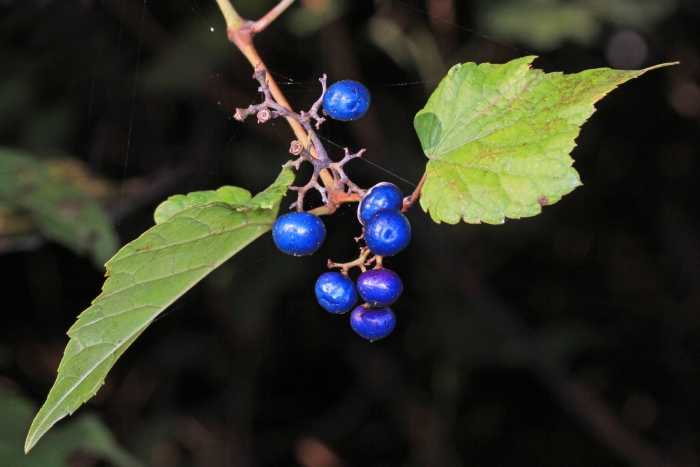Porcelain Berry
(Ampelopsis glandulosa var. brevipedunculata)
Porcelain Berry (Ampelopsis glandulosa var. brevipedunculata)
/
/

© Judy Gallagher
CC BY-SA 4.0
Image By:
© Judy Gallagher
Recorded By:
Copyright:
CC BY-SA 4.0
Copyright Notice:
Photo by: © Judy Gallagher | License Type: CC BY-SA 4.0 | License URL: http://creativecommons.org/licenses/by-sa/4.0/ | Uploader: judygva | Publisher: iNaturalist |












































Estimated Native Range
Summary
Ampelopsis glandulosa var. brevipedunculata, commonly known as porcelain berry, is a deciduous, woody, perennial climbing vine native to temperate regions of Asia, including China, Korea, and Japan. It thrives in a variety of habitats, such as forest edges, stream banks, and disturbed areas, where it can rapidly climb over other vegetation. The vine can reach heights of 4-6 meters (15-20 feet), using tendrils to ascend. Its palmately lobed leaves are an attractive feature, and from June to August, it produces inconspicuous green-white flowers in umbels opposite the leaves. The most striking feature of porcelain berry is its fruit: clusters of berries that change color from green to shades of lilac, purple, and bright blue as they mature.
Porcelain berry is valued for its ornamental berries and vigorous growth, making it a popular choice for covering walls, arbors, and trellises. However, it requires careful management to prevent it from overwhelming other plants and structures. It is adaptable to a range of soil types, provided they have good drainage, and it performs best in full sun to part shade. While it can tolerate medium amounts of water, it is somewhat drought-tolerant once established. Gardeners should be aware of its potential to spread and become invasive, especially in North America, where it can outcompete native plants and disrupt local ecosystems.CC BY-SA 4.0
Porcelain berry is valued for its ornamental berries and vigorous growth, making it a popular choice for covering walls, arbors, and trellises. However, it requires careful management to prevent it from overwhelming other plants and structures. It is adaptable to a range of soil types, provided they have good drainage, and it performs best in full sun to part shade. While it can tolerate medium amounts of water, it is somewhat drought-tolerant once established. Gardeners should be aware of its potential to spread and become invasive, especially in North America, where it can outcompete native plants and disrupt local ecosystems.CC BY-SA 4.0
Plant Description
- Plant Type: Vine
- Height: 10-12 feet
- Width: 5-10 feet
- Growth Rate: Rapid
- Flower Color: N/A
- Flowering Season: Summer
- Leaf Retention: Deciduous
Growth Requirements
- Sun: Full Sun, Part Shade
- Water: Medium
- Drainage: Slow, Medium, Fast
Common Uses
Bank Stabilization, Bird Garden, Drought Tolerant, Rock Garden
Natural Habitat
Native to temperate regions of Asia, including forest edges and stream banks
Other Names
Common Names: Creeper, Porcelain Berry, Porcelain Vine
Scientific Names: , Ampelopsis glandulosa var. brevipedunculata, Ampelopsis brevipedunculata, Vitis brevipedunculata, Ampelopsis heterophylla var. brevipedunculata, Ampelopsis brevipedunculata f. puberula, Ampelopsis heterophylla var. amurensis, Ampelopsis heterophylla var. humulifolia, Cissus brevipedunculata, Cissus humulifolia var. brevipedunculata,
GBIF Accepted Name: Ampelopsis heterophylla var. brevipedunculata (Maxim. ex Trautv.) C.L.Li